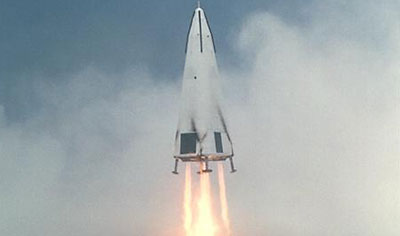Lincoln and railroads, Obama and RLVs?by Taylor Dinerman
|
| The travails of the DC-X, the X-33, the X-37, the Orbital Space Plane, and other programs have been as frustrating to serious advocates of space exploration and settlement as the congressional battles of the 1850s must have been to the Californians of that age. |
Eight years ago the bipartisan Calvert-Ortiz Bill proposed to give tax credits to investors in firms that were building reusable launch vehicles (RLVs). The idea never went anywhere due mostly to the method by which it was “scored” by the House Ways and Means Committee. They estimated that it would cost several billions in tax revenue over the short run. Of course, a successful US RLV industry would return tens of billions in revenue to the US treasury over a couple of decades, not to mention the gigantic increase in economic activity that would naturally follow from the opening up of the space frontier.
A few gutsy entrepreneurs, such as Jeff Bezos and Elon Musk, are risking their own money to build a new generation of low-cost, reliable, and at least partly reusable rockets that can put payloads and people into space. There is also an infant suborbital space tourism industry that may—repeat, may—one day produce a new class of orbital transportation vehicles.
In fact, no one really knows how much investment a successful RLV will require. Unlike the railroads of the 1860s there is no real body of data on which to base a reliable estimate. Suborbital systems can be developed for tens of millions of dollars: Scaled Composites was able to build the Ansari X Prize-winning SpaceShipOne for roughly twenty million, while the DC-X program of the early 1990s cost less than eighty million in then-year dollars. It is hard to imagine that a fully-reusable orbital vehicle can be built for less than a couple of billion or more, especially if it were built following the normal contracting and procurement regulations.
Even if the system was to be reformed, the costs of RLV development will still be a hugely expensive proposition. Within the Defense Department there are now a few modest programs aimed at pushing forward the state of the art of this technology, but they lack a focus and are vulnerable to cuts. In the aftermath of the February 2003 Columbia shuttle disaster, NASA got out of the RLV development business; in fact, the agency’s technology program has been reduced to Constellation and to a few projects supported by the Science Mission Directorate.
Yet no one who has seriously looked at the issue has any doubt that a fully-operational RLV would revolutionize space transportation and with it the whole human economy the same way that the Union Pacific helped turn America into an economic superpower. Opening up the solar system to human use would be the biggest change since people learned to use the air for something other than breathing and burning stuff.
Broadly speaking there are two paths to an effective, economically viable, and safe RLV. The first is the one being undertaken by Jeff Bezos and his Blue Origin team, and was proposed by the late Max Hunter in the late 1980s. It consists of a step-by-step process sometimes called “build a little, test a little, fly a little”. The first attempt made to follow this path was the famous DC-X program, which died not due to the inevitable test failures but instead due to a lack of interest from the Clinton Administration, who pushed the X-33 as the solution to the shuttle replacement problem. We all know how that program ended.
| Let the entrepreneurs, and the designers and engineers who work for them, make the decisions, not NASA and the politicians. Encourage new ideas and encourage investors to put their money into this industry. |
The second way is exemplified by Elon Musk’s SpaceX. This builds a system that can get into orbit and worries about making it fully or partially reusable later. This was, at least to some extent, the approach taken by those who designed the shuttle in the early 1970s. NASA’s effort to make the new Orion capsule at least partially reusable is a faint echo of this idea. Other related ideas include the Dream Chaser spaceplane, which Sierra Nevada Corporation (which bought SpaceDev last year) is working on.
So far neither concept can be said to have proven itself. This is perhaps the best argument for a new Calvert-Ortiz bill. Let the entrepreneurs, and the designers and engineers who work for them, make the decisions, not NASA and the politicians. Encourage new ideas and encourage investors to put their money into this industry. Building RLVs is hard. Getting to Mach 25 is hard. Surviving reentry is hard. Taking technological risks with unproven hardware is risky, and not something the government is good at, especially with the spur of war or cold war to put the fear of God (and the voters) into the nation’s leaders.
The railroad bills that President Lincoln signed gave an obscene amount of land to the companies that promised to build the transcontinental link. At the time the US government had lots and lots of land to give away. Today the folks in Washington cannot give anyone millions of acres of prime real estate, and the Outer Space Treaty insures that they cannot give away bits of the Moon or other “celestial bodies”. What they do have lots of is the power to write tax laws, and harnessing this power to build a new industry would be a truly Lincolnesque act of leadership.
